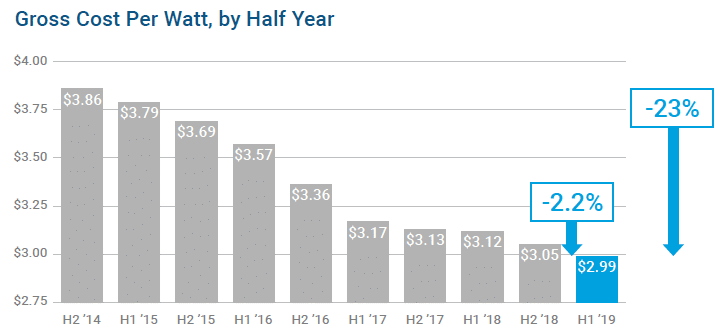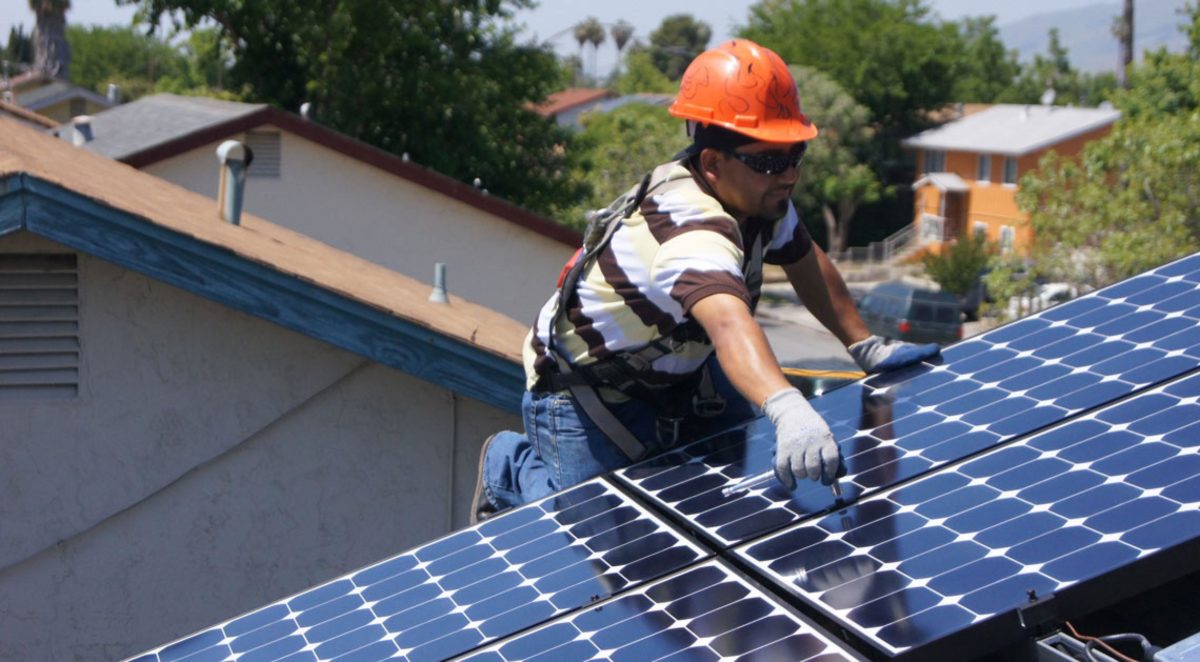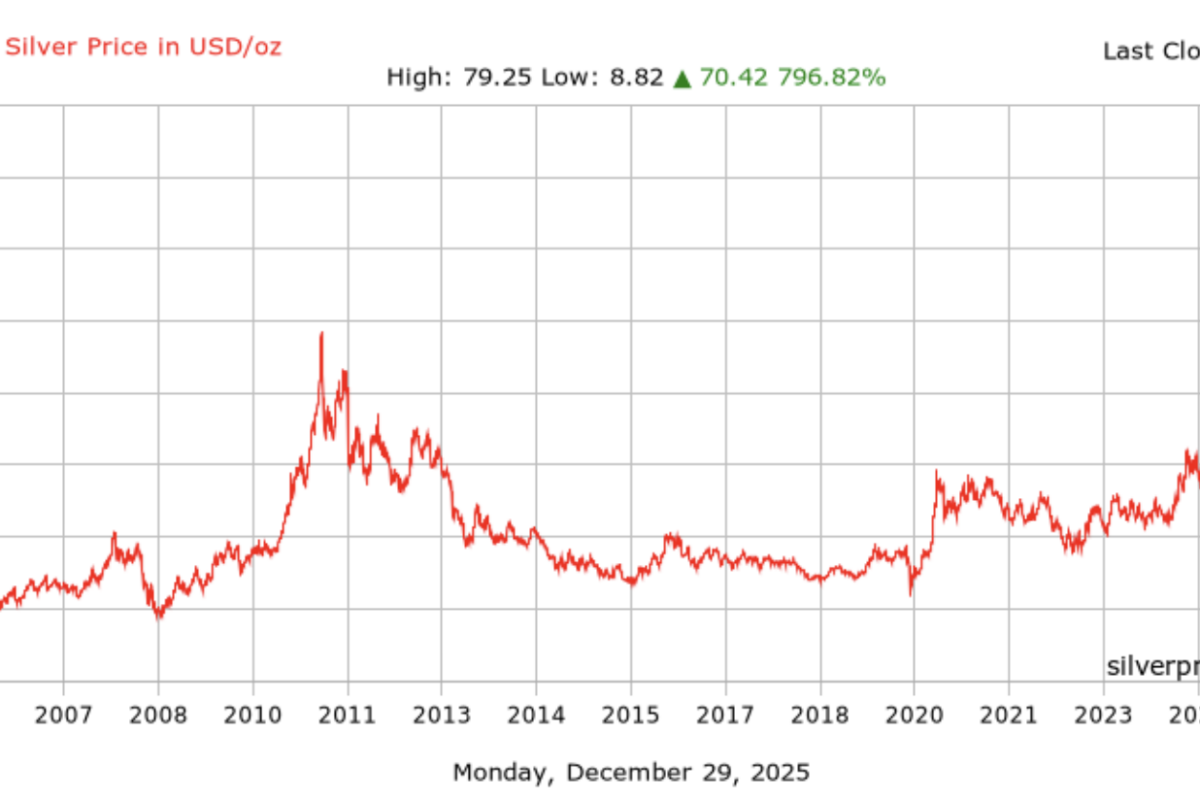EnergySage’s Solar Marketplace Intel Reports provide yet another view into the evolution of the rooftop solar industry. As the company’s online marketplace is only a small portion of the overall behind-the-meter market, this report does not provide as definitive of data as those by the U.S. Department of Energy’s network of national laboratories. However it complements these, data from the state of California and quarterly reports from large publicly held companies in giving a more full understanding of market trends.
The latest Solar Marketplace Intel Report starts with a shocking number: the average price for PV systems quoted through the EnergySage online solar marketplace in the first half of 2019 had fallen to $2.99 per watt-dc. This is a decline of more than 4% versus a year ago, and 23% less than four and a half years ago, when EnergySage began counting.

And, if you look at the distribution of costs, this shows that the due to the data being skewed somewhat by more expensive systems, many systems were substantially less expensive than this.
This trend matches that shown in Lawrence Berkley National Laboratory’s Tracking the Sun series. The latest version of Tracking The Sun, published earlier this month, shows a median system price of $3.70 per watt-dc across the United States in 2018. While this is 24% higher than EnergySage’s quotes, it shows a 5% decline from 2017 to 2018.
The third-party exception
However, neither the Solar Marketplace Intel report nor Tracking the Sun show all solar installations; chiefly Tracking the Sun excludes all solar sold under lease or power purchase agreement arrangements, dubbed “third-party-owned” solar. Likewise, EnergySage excludes data from Sunrun, Vivint and Tesla, which are the three largest third-party solar providers, and, with the exception of SunPower and its dealer network, the three largest companies in the residential space.
Tracking the Sun shows prices third-party systems tracking closely to “host-owned” systems, but Berkeley Lab’s data stops at 2018. In 2019, costs have been increasing at both Sunrun and Vivint, which are the only solar companies that provide system price data as part of their quarterly results. And it is unclear how much these costs are being passed on to customers.

System costs at Sunrun increased 6% in the first quarter of 2019 and 2% in the second quarter over full year 2018 levels. Vivint saw an even higher increase in costs, with prices growing 7% year-over-year in the first quarter and 10% in the second quarter, to rise to $3.56 per watt. In both cases, rising sales, general and administrative costs were the main driver.
These rising costs are likely to have inspired Tesla’s move to online sales, which has allowed it to slash costs to below $2 per watt for residential systems. However, it remains to be seen if this move will turn around the fortunes of Tesla’s share of the rooftop solar market, which has plummeted.
And despite rising costs the market share of both Sunrun and Vivint are increasing. This is happening even as the total share of third-party solar has fallen sharply due to the contraction in Tesla’s sales.
Falling costs
It’s important not to read too much into EnergySage’s data, as the prices listed are the prices of quotes, not the final systems installed, and it is possible that these prices were higher. However, the trend from both EnergySage and Berkeley Lab is clear: residential solar continues to get cheaper.
There remains a big question mark around the third-party solar model, and whether or not companies in this space can contain the rising costs that have been seen so far this year, which is particularly important given the trend of ongoing assaults against net metering. The basic model of third-party solar companies, which is dependent on long-term financing, may insulate them somewhat from short-term trends. But eventually even they have to turn a profit.
Meanwhile, the online solar marketplace model continues to grow. EnergySage estimates that 3-4% of all of the residential solar in this United States installed last year was sold through its site, and the company says that it is seeing “near triple-digit growth” from year to year.
This content is protected by copyright and may not be reused. If you want to cooperate with us and would like to reuse some of our content, please contact: editors@pv-magazine.com.









I just got generic quote info from Solar United Neighbors which is doing their first sign-up in Denver. If you live in Denver and are looking for solar you definitely need to look into it. I am not allowed to say what the price is, but it is significantly below pricing quoted from Energy Sage or Tracking the Sun. Last I heard they had 50 people signed up for preliminary bids. It is no obligation to sign-up, if you don’t like what you are told you don’t have to continue. So, nothing to lose – except your utility payment.
Below $2/watt is absurd and all that encourages is a race to the bottom. In solar, cheap is not good and good is not cheap. How can a company sustain that model long term?
In 2005 I had a 8.4kWp solar PV system installed on the roof of my home. At that time and with some subsidies from the utility itself, $2.48 per AC watt of generated power a one time rebate and at that time a capped federal tax write off of $2,000. With the rebates and tax ‘incentive’ the system cost me about $6.50 per installed watt. Bought another house, finally sold the old house. I was unable to use the 30% ITC for the new house when I had solar PV installed on the new house in 2016. The cost of this system which is 14.5kWp was $3.50 in 2016. Now folks are able to install relatively large solar PV systems with energy storage for $35 to $40k without the 30% ITC. As solar PV panels become more efficient, the ‘promise’ of tandem cell panels can push the solar harvest from the standard 18% to 20% for panels now, to the full blown tandem cell with 35% solar harvest. More bang for the buck, less panels, less cost, more generated output per square foot of panel installed. Next will be energy storage will come down in price and the systems will store more energy than the current systems being installed. IF you want to install your own systems today, you can find sites that sell solar PV kits and the BOS components to do the job. One can install a 10.5kWp system for right around $18k, about $1.70 per watt installed. No ITC, just out of pocket costs. I have witnessed in my lifetime, the 1973 oil embargo, the 1977 oil embargo part deux and solar panels going from $45 to $50 a watt to less than a dollar per watt (with) tariffs. So, I’m sorry if my opinion after all of these years doesn’t support the “doesn’t pencil out”, “what’s the ROI”, “we’re not there yet pundits”. I have suffered too many outrages over decades to believe in those uttered stupidities anymore. Legacy, what is your legacy going to be to the next generation?